Interactions
Timber rattlesnakes interact with many different kinds of
animals and perform several important roles within their environment.
Primarily, timber rattlesnakes are predatory animals, which means they prey
upon other small animals and carry out specific mechanisms for capturing and
acquiring their victims. Being heterotro phic and unable to produce
their own food, they are not at the bottom of the food web. Instead,
they feed on animals that consume other animals or they feed on animals that
consume other types of organisms, such as plants. They usually prefer
to feed on small, warm-blooded mammals, which makes them great contributors
to the control of rodent populations within the environment. Though timber
rattlesnakes are not at the bottom of the food chain, they are also not at
the top. In fact, C. horridus is preyed upon and consumed by
many other animals, such as coyotes, foxes, raccoons, opossums, cats
(domesticated and feral), eagles,
hawks,
owls, turkeys, and even other
snakes. These snakes however, are much larger, like the king snake.
Unfortunately, timber rattlesnakes are also hunted and killed by humans for
various reasons. By acting as both a predator and prey, timber
rattlesnakes play a major ecological role within their environment to help
maintain the "balance of nature".
phic and unable to produce
their own food, they are not at the bottom of the food web. Instead,
they feed on animals that consume other animals or they feed on animals that
consume other types of organisms, such as plants. They usually prefer
to feed on small, warm-blooded mammals, which makes them great contributors
to the control of rodent populations within the environment. Though timber
rattlesnakes are not at the bottom of the food chain, they are also not at
the top. In fact, C. horridus is preyed upon and consumed by
many other animals, such as coyotes, foxes, raccoons, opossums, cats
(domesticated and feral), eagles,
hawks,
owls, turkeys, and even other
snakes. These snakes however, are much larger, like the king snake.
Unfortunately, timber rattlesnakes are also hunted and killed by humans for
various reasons. By acting as both a predator and prey, timber
rattlesnakes play a major ecological role within their environment to help
maintain the "balance of nature".
During the winter months, when snakes of all types retreat back to their
annual dens, timber rattlesnakes will often share a den with many other
snakes. Some of these snakes are of the exact same species (meaning timber
rattlesnakes), but a fair amount are also individuals of a different
species. Bull snakes, black snakes, garter snakes, copperheads, milk
snakes and prairie ring-neck snakes, are just a few of the many other
species that share a den with C. horridus. Typically, there
is very little interaction among the various species of snakes within the
den unless they are related. For this reason, timber rattlesnakes form
a mutualistic type of relationship with these other snake species, in which they
can both live and survive in the same area without causing harm to the
other.
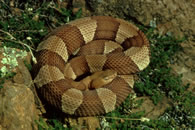

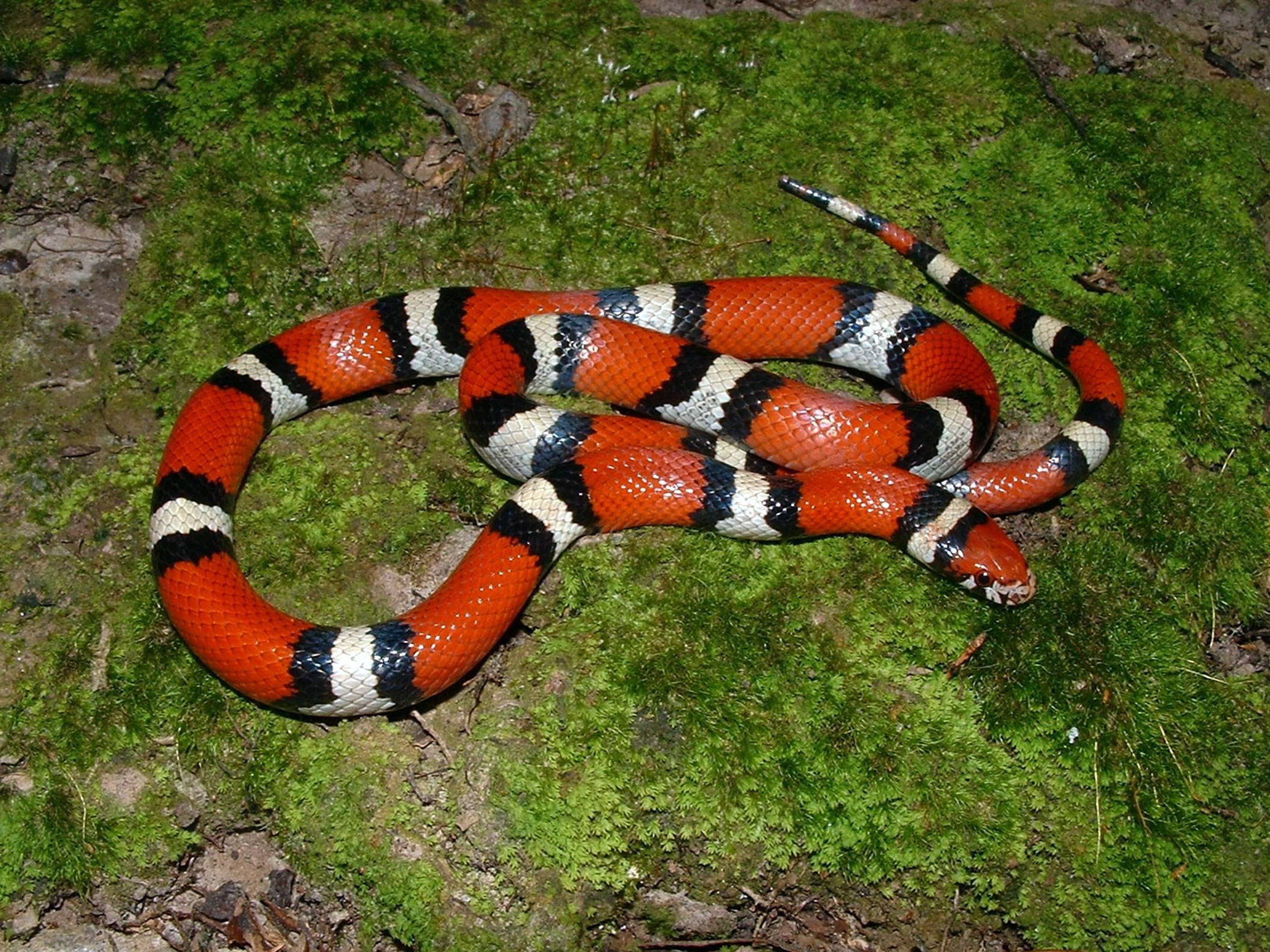
Copperhead snake
Bull snake
Red milk snake
Nutrition



Like all
animals, C. horridus is a heterotroph, meaning it cannot produce
its own food. It must rely on other organisms to acquire the nutrients and
energy its body needs in order to function. C. horridus is a
carnivorous predator that preys mainly upon small, warm-blooded mammals,
such as chipmunks, voles, shrews, mice,
ground squirrels, rabbits,
weasels and
rats. They have been known to consume birds, bird eggs, insects, amphibians,
and other reptiles, such as snakes, lizards and
frogs, but this diet is far less common. In order to capture its prey, C. horridus relies heavily on
their sense of smell, taste and vibration. This includes the use
of many important sensory organs and structures, as well as one of their
most notable attributes: their venomous fangs.
Since C.
horridus is a pit viper, one of its most useful sensory organs is a
pair of facial pits located on each side of the head. Each pit, found
midway between the eyes and the nostrils, contains several nerve endings
that can sense body heat of warm blooded animals from several feet away.
These heat-sensitive openings are important in allowing the rattlesnake to
detect when a prey item is close enough to strike and what type of prey
source is present. After detecting a possible food source, timber
rattlesnakes will lunge at their prey as soon as it comes enough. Then,
C. horridus will sink its large fangs into the body of the animal,
paralyzing it almost instantly. The fangs are long, hollow teeth located in
the upper jaw and will fold back into the mouth when not in use. The venom
issued from these fangs form in glands behind the teeth in the upper jaw.
When the rattlesnake
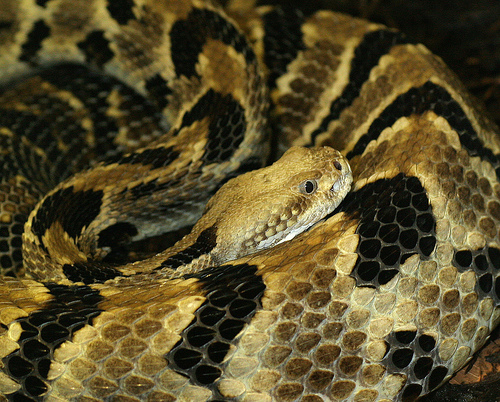 strikes, the muscles surrounding the poison glands
contract, squeezing the venom out and into the victim. Once bitten, the
rattlesnake will let go, allowing the prey to withdraw and run away if it
can. Unfortunately, it only takes a matter of minutes for the venom to kick
in, but the rattlesnake won't consume the animal until it is officially
dead. Next, the rattlesnake will rapidly track down its prey by using a
flickering motion of its tongue to detect the prey's scent. By flicking the
tongue in and out of the oral cavity, it can absorb molecules and chemicals
in the air and associate them with animals present in the area, especially
its prey. Besides having two nostrils for smell, timber rattlesnakes also
possess a special sensory organ called Jacobson's organ that also aids in
the detection of prey sources. It is located on the roof of the mouth and
works in sync with the tongue by filtering and identifying the molecules the
tongue picks up from the air and ground. Now the rattlesnake can finally
consume its prey. Unlike many other animals, which typically grind and chew
their food with teeth as a a way of pre-digesting their food, C.
horridus simply swallows its entire prey whole. It doesn't leave a
single crumb on its plate! The rattlesnake will then retreat to a sunny
basking site in order to raise its body temperature for proper digestion.
The optimal temperature for digestion is generally around 80-85 degrees
Fahrenheit for maximum efficient digestion.
strikes, the muscles surrounding the poison glands
contract, squeezing the venom out and into the victim. Once bitten, the
rattlesnake will let go, allowing the prey to withdraw and run away if it
can. Unfortunately, it only takes a matter of minutes for the venom to kick
in, but the rattlesnake won't consume the animal until it is officially
dead. Next, the rattlesnake will rapidly track down its prey by using a
flickering motion of its tongue to detect the prey's scent. By flicking the
tongue in and out of the oral cavity, it can absorb molecules and chemicals
in the air and associate them with animals present in the area, especially
its prey. Besides having two nostrils for smell, timber rattlesnakes also
possess a special sensory organ called Jacobson's organ that also aids in
the detection of prey sources. It is located on the roof of the mouth and
works in sync with the tongue by filtering and identifying the molecules the
tongue picks up from the air and ground. Now the rattlesnake can finally
consume its prey. Unlike many other animals, which typically grind and chew
their food with teeth as a a way of pre-digesting their food, C.
horridus simply swallows its entire prey whole. It doesn't leave a
single crumb on its plate! The rattlesnake will then retreat to a sunny
basking site in order to raise its body temperature for proper digestion.
The optimal temperature for digestion is generally around 80-85 degrees
Fahrenheit for maximum efficient digestion.
The first stage of digestion occurs
when the body of the animal passes through the esophagus of the rattlesnake.
The venom secreted by the fangs helps break down the food along with other
digestive enzymes secreted by other organs of the digestive tract. The
esophagus of C. horridus is extremely long, almost half the length
of its entire body, and creates peristaltic movements that propels the food
down into the stomach where gastric juices are released to aid in
breakdown. The partially digeste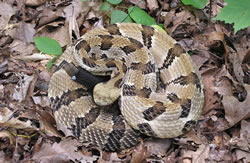 d animal then enters the small intestine,
which is a small narrow coil where nutrients are absorbed into the blood.
Reptiles, such as C. horridus, contain closed circulatory systems,
meaning that the blood is confined in vessels that travel throughout the
body, distributing nutrients and minerals as it flows. One advantage that
C. horridus has over other reptiles is that it contains more
internal folds within its digestive tract. This key feature creates a
larger surface area for absorption, thus greater nutrient acquisition.
After passing through the large intestine, the content moves into the
cloacae chamber, which is a structure that only reptiles usually have. This
cloaca is not only important for the excretion of wastes, but also for water
retention which prevents the rattlesnake from becoming dehydrated. One
digestive cycle usually takes about four days to complete, however, the rate
of digestion may vary depending on body temperature.
d animal then enters the small intestine,
which is a small narrow coil where nutrients are absorbed into the blood.
Reptiles, such as C. horridus, contain closed circulatory systems,
meaning that the blood is confined in vessels that travel throughout the
body, distributing nutrients and minerals as it flows. One advantage that
C. horridus has over other reptiles is that it contains more
internal folds within its digestive tract. This key feature creates a
larger surface area for absorption, thus greater nutrient acquisition.
After passing through the large intestine, the content moves into the
cloacae chamber, which is a structure that only reptiles usually have. This
cloaca is not only important for the excretion of wastes, but also for water
retention which prevents the rattlesnake from becoming dehydrated. One
digestive cycle usually takes about four days to complete, however, the rate
of digestion may vary depending on body temperature.
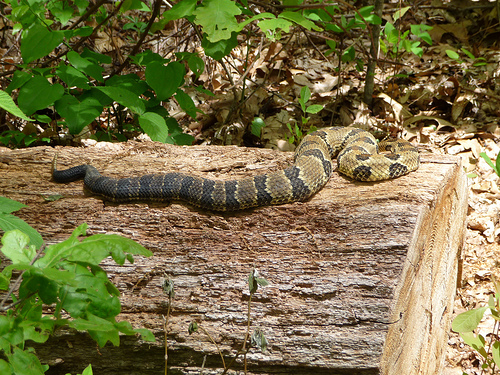 Another dietary tactic that C.
horridus uses to capture its prey is by laying motionless on the ground
near a log or by resting its head on a log and waiting for an animal to
approach. Once the animal enters the log, vibrations through the log alert
the snake that a possible meal is present. The vibrations travel from the
log into the center of the lower jaw and through the connecting skull bones
of the rattlesnake. These vibrations not only alert the rattlesnake of
possible prey, but they also reveal information about the size of the
animal. The rattlesnake will then position itself appropriately in
order to strike. For this reason, timber rattlesnakes are often
thought of as ambush predators: they conceal themselves extremely well and
then attack once a prey source approaches. It appears to be a very a
successful method of predation. C. horridus is diurnal
during the spring and fall, meaning it is more active during the day than
the night, but is
nocturnal during the summer when the heat is overbearing. The
typical routine of C. horridus includes basking in the sun during
the day to promote digestion and then foraging at night when food is abundant.
Another dietary tactic that C.
horridus uses to capture its prey is by laying motionless on the ground
near a log or by resting its head on a log and waiting for an animal to
approach. Once the animal enters the log, vibrations through the log alert
the snake that a possible meal is present. The vibrations travel from the
log into the center of the lower jaw and through the connecting skull bones
of the rattlesnake. These vibrations not only alert the rattlesnake of
possible prey, but they also reveal information about the size of the
animal. The rattlesnake will then position itself appropriately in
order to strike. For this reason, timber rattlesnakes are often
thought of as ambush predators: they conceal themselves extremely well and
then attack once a prey source approaches. It appears to be a very a
successful method of predation. C. horridus is diurnal
during the spring and fall, meaning it is more active during the day than
the night, but is
nocturnal during the summer when the heat is overbearing. The
typical routine of C. horridus includes basking in the sun during
the day to promote digestion and then foraging at night when food is abundant.
Back To Home Page
To learn some more Interesting Facts about this organism, click
here